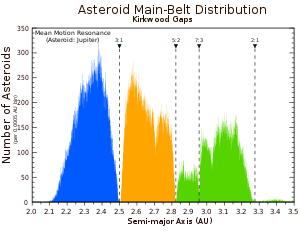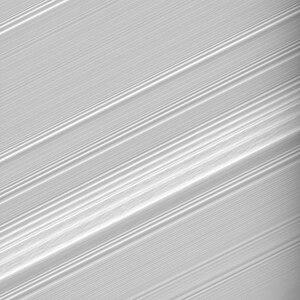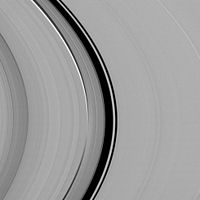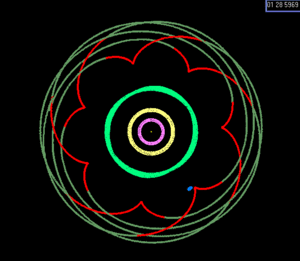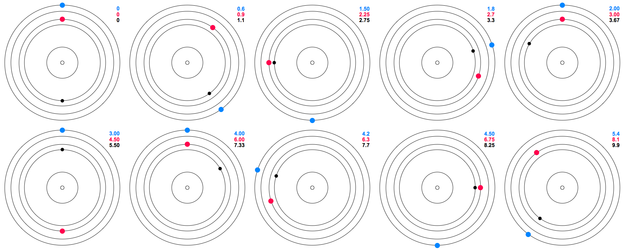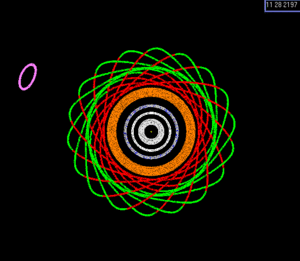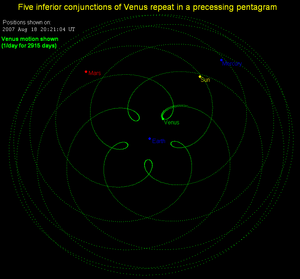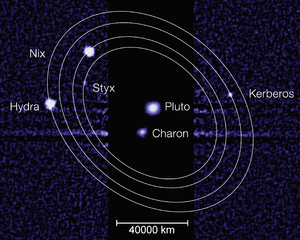An unusual case of a three-body resonance among Jupiter's Galilean moons
In celestial mechanics, an orbital resonance occurs when orbiting bodies exert a regular, periodic gravitational influence on each other, usually because their orbital periods are related by a ratio of small integers. Most commonly this relationship is found for a pair of objects. The physics principle behind orbital resonance is similar in concept to pushing a child on a swing, where the orbit and the swing both have a natural frequency, and the other body doing the "pushing" will act in periodic repetition to have a cumulative effect on the motion. Orbital resonances greatly enhance the mutual gravitational influence of the bodies, i.e. their ability to alter or constrain each other's orbits. In most cases, this results in an unstable interaction, in which the bodies exchange momentum and shift orbits until the resonance no longer exists. Under some circumstances, a resonant system can be stable and self-correcting, so that the bodies remain in resonance. Examples are the 1:2:4 resonance of Jupiter's moons Ganymede, Europa and Io, and the 2:3 resonance between Pluto and Neptune. Unstable resonances with Saturn's inner moons give rise to gaps in the rings of Saturn. The special case of 1:1 resonance between bodies with similar orbital radii causes large Solar System bodies to eject most other bodies sharing their orbits; this is part of the much more extensive process of clearing the neighbourhood, an effect that is used in the current definition of a planet.
A binary resonance ratio in this article should be interpreted as the ratio of number of orbits completed in the same time interval, rather than as the ratio of orbital periods, which would be the inverse ratio. Thus the 2:3 ratio above means Pluto completes two orbits in the time it takes Neptune to complete three. In the case of resonance relationships among three or more bodies, either type of ratio may be used (in such cases the smallest whole-integer ratio sequences are not necessarily reversals of each other) and the type of ratio will be specified.
History
Since the discovery of Newton's law of universal gravitation in the 17th century, the stability of the Solar System has preoccupied many mathematicians, starting with Laplace. The stable orbits that arise in a two-body approximation ignore the influence of other bodies. The effect of these added interactions on the stability of the Solar System is very small, but at first it was not known whether they might add up over longer periods to significantly change the orbital parameters and lead to a completely different configuration, or whether some other stabilising effects might maintain the configuration of the orbits of the planets.It was Laplace who found the first answers explaining the linked orbits of the Galilean moons (see below). Before Newton, there was also consideration of ratios and proportions in orbital motions, in what was called "the music of the spheres", or Musica universalis.
Types of resonance
The semimajor axes of resonant trans-Neptunian objects (red) are clumped at locations of low-integer resonances with Neptune (vertical red bars near top), in contrast to those of cubewanos (blue) and nonresonant (or not known to be resonant) scattered objects (grey).
A chart of the distribution of asteroid semimajor axes, showing the Kirkwood gaps where orbits are destabilized by resonances with Jupiter
Spiral density waves in Saturn's A Ring excited by resonances with inner moons.
Such waves propagate away from the planet (towards upper left). The
large set of waves just below center is due to the 6:5 resonance with Janus.
The eccentric Titan Ringlet in the Columbo Gap of Saturn's C Ring (center) and the inclined orbits of resonant particles in the bending wave just inside it have apsidal and nodal precessions, respectively, commensurate with Titan's mean motion.
- involve one or any combination of the orbit parameters (e.g. eccentricity versus semimajor axis, or eccentricity versus orbital inclination).
- act on any time scale from short term, commensurable with the orbit periods, to secular, measured in 104 to 106 years.
- lead to either long-term stabilization of the orbits or be the cause of their destabilization.
- The orbits of Pluto and the plutinos are stable, despite crossing that of the much larger Neptune, because they are in a 2:3 resonance with it. The resonance ensures that, when they approach perihelion and Neptune's orbit, Neptune is consistently distant (averaging a quarter of its orbit away). Other (much more numerous) Neptune-crossing bodies that were not in resonance were ejected from that region by strong perturbations due to Neptune. There are also smaller but significant groups of resonant trans-Neptunian objects occupying the 1:1 (Neptune trojans), 3:5, 4:7, 1:2 (twotinos) and 2:5 resonances, among others, with respect to Neptune.
- In the asteroid belt beyond 3.5 AU from the Sun, the 3:2, 4:3 and 1:1 resonances with Jupiter are populated by clumps of asteroids (the Hilda family, the few Thule asteroids, and the numerous Trojan asteroids, respectively).
- In the asteroid belt within 3.5 AU from the Sun, the major mean-motion resonances with Jupiter are locations of gaps in the asteroid distribution, the Kirkwood gaps (most notably at the 4:1, 3:1, 5:2, 7:3 and 2:1 resonances). Asteroids have been ejected from these almost empty lanes by repeated perturbations. However, there are still populations of asteroids temporarily present in or near these resonances. For example, asteroids of the Alinda family are in or close to the 3:1 resonance, with their orbital eccentricity steadily increased by interactions with Jupiter until they eventually have a close encounter with an inner planet that ejects them from the resonance.
- In the rings of Saturn, the Cassini Division is a gap between the inner B Ring and the outer A Ring that has been cleared by a 2:1 resonance with the moon Mimas. (More specifically, the site of the resonance is the Huygens Gap, which bounds the outer edge of the B Ring.)
- In the rings of Saturn, the Encke and Keeler gaps within the A Ring are cleared by 1:1 resonances with the embedded moonlets Pan and Daphnis, respectively. The A Ring's outer edge is maintained by a destabilizing 7:6 resonance with the moon Janus.
A Laplace resonance is a three-body resonance with a 1:2:4 orbital period ratio (equivalent to a 4:2:1 ratio of orbits). The term arose because Pierre-Simon Laplace discovered that such a resonance governed the motions of Jupiter's moons Io, Europa, and Ganymede. It is now also often applied to other 3-body resonances with the same ratios, such as that between the extrasolar planets Gliese 876 c, b, and e. Three-body resonances involving other simple integer ratios have been termed "Laplace-like"[9] or "Laplace-type".
A Lindblad resonance drives spiral density waves both in galaxies (where stars are subject to forcing by the spiral arms themselves) and in Saturn's rings (where ring particles are subject to forcing by Saturn's moons).
A secular resonance occurs when the precession of two orbits is synchronised (usually a precession of the perihelion or ascending node). A small body in secular resonance with a much larger one (e.g. a planet) will precess at the same rate as the large body. Over long times (a million years, or so) a secular resonance will change the eccentricity and inclination of the small body.
Several prominent examples of secular resonance involve Saturn. A resonance between the precession of Saturn's rotational axis and that of Neptune's orbital axis (both of which have periods of about 1.87 million years) has been identified as the likely source of Saturn's large axial tilt (26.7°). Initially, Saturn probably had a tilt closer to that of Jupiter (3.1°). The gradual depletion of the Kuiper belt would have decreased the precession rate of Neptune's orbit; eventually, the frequencies matched, and Saturn's axial precession was captured into the spin-orbit resonance, leading to an increase in Saturn's obliquity. (The angular momentum of Neptune's orbit is 104 times that of Saturn's spin, and thus dominates the interaction.)
The perihelion secular resonance between asteroids and Saturn (ν6 = g − g6) helps shape the asteroid belt (the subscript "6" identifies Saturn as the sixth planet from the Sun). Asteroids which approach it have their eccentricity slowly increased until they become Mars-crossers, at which point they are usually ejected from the asteroid belt by a close pass to Mars. This resonance forms the inner and "side" boundaries of the asteroid belt around 2 AU, and at inclinations of about 20°.
Numerical simulations have suggested that the eventual formation of a perihelion secular resonance between Mercury and Jupiter (g1 = g5) has the potential to greatly increase Mercury's eccentricity and possibly destabilize the inner Solar System several billion years from now.
The Titan Ringlet within Saturn's C Ring represents another type of resonance in which the rate of apsidal precession of one orbit exactly matches the speed of revolution of another. The outer end of this eccentric ringlet always points towards Saturn's major moon Titan.
A Kozai resonance occurs when the inclination and eccentricity of a perturbed orbit oscillate synchronously (increasing eccentricity while decreasing inclination and vice versa). This resonance applies only to bodies on highly inclined orbits; as a consequence, such orbits tend to be unstable, since the growing eccentricity would result in small pericenters, typically leading to a collision or (for large moons) destruction by tidal forces.
In an example of another type of resonance involving orbital eccentricity, the eccentricities of Ganymede and Callisto vary with a common period of 181 years, although with opposite phases.
Mean-motion resonances in the Solar System
Depiction of Haumea's presumed 7:12 resonance with Neptune in a rotating frame,
with Neptune (blue dot at lower right) held stationary. Haumea's
shifting orbital alignment relative to Neptune periodically reverses (librates), preserving the resonance.
The Laplace resonance exhibited by three of the Galilean moons. The ratios in the figure are of orbital periods.
Conjunctions are highlighted by brief color changes. There are two
Io-Europa conjunctions (green) and three Io-Ganymede conjunctions (grey)
for each Europa-Ganymede conjunction (magenta).
- 2:3 Pluto–Neptune (also Orcus and other plutinos)
- 2:4 Tethys–Mimas (Saturn's moons). Not simplified, because the libration of the nodes must be taken into account.
- 1:2 Dione–Enceladus (Saturn’s moons)
- 3:4 Hyperion–Titan (Saturn's moons)
- 1:2:4 Ganymede–Europa–Io (Jupiter's moons, ratio of orbits).
The simple integer ratios between periods hide more complex relations:
- the point of conjunction can oscillate (librate) around an equilibrium point defined by the resonance.
- given non-zero eccentricities, the nodes or periapsides can drift (a resonance related, short period, not secular precession).
 (inverse of periods, often expressed in degrees per day) would satisfy the following
(inverse of periods, often expressed in degrees per day) would satisfy the following
Actually, the resonance is perfect, but it involves also the precession of perijove (the point closest to Jupiter),
 . The correct equation (part of the Laplace equations) is:
. The correct equation (part of the Laplace equations) is:
Laplace resonance
Illustration of Io–Europa–Ganymede resonance. From the centre outwards: Io (yellow), Europa (gray) and Ganymede (dark)
The Laplace resonance involving Io–Europa–Ganymede includes the following relation locking the orbital phase of the moons:
 are mean longitudes of the moons (the second equals sign ignores libration).
This relation makes a triple conjunction impossible. (A Laplace resonance in the Gliese 876
system, in contrast, is associated with one triple conjunction per
orbit of the outermost planet, ignoring libration.) The graph
illustrates the positions of the moons after 1, 2 and 3 Io periods.
are mean longitudes of the moons (the second equals sign ignores libration).
This relation makes a triple conjunction impossible. (A Laplace resonance in the Gliese 876
system, in contrast, is associated with one triple conjunction per
orbit of the outermost planet, ignoring libration.) The graph
illustrates the positions of the moons after 1, 2 and 3 Io periods.  librates about 180° with an amplitude of 0.03°.
librates about 180° with an amplitude of 0.03°.Another "Laplace-like" resonance involves the moons Styx, Nix and Hydra of Pluto:
 librates about 180° with an amplitude of at least 10°.
librates about 180° with an amplitude of at least 10°.Plutino resonances
The dwarf planet Pluto is following an orbit trapped in a web of resonances with Neptune. The resonances include:- A mean-motion resonance of 2:3
- The resonance of the perihelion (libration around 90°), keeping the perihelion above the ecliptic
- The resonance of the longitude of the perihelion in relation to that of Neptune
The next largest body in a similar 2:3 resonance with Neptune, called a plutino, is the probable dwarf planet Orcus. Orcus has an orbit similar in inclination and eccentricity to Pluto's. However, the two are constrained by their mutual resonance with Neptune to always be in opposite phases of their orbits; Orcus is thus sometimes described as the "anti-Pluto".
Mean-motion resonances among extrasolar planets
While most extrasolar planetary systems discovered have not been found to have planets in mean-motion resonances, chains of up to five resonant planets and up to seven at least near resonant planets have been uncovered. Simulations have shown that during planetary system formation, the appearance of resonant chains of planetary embryos is favored by the presence of the primordial gas disc. Once that gas dissipates, 90-95% of those chains must then become unstable to match the low frequency of resonant chains observed.- As mentioned above, Gliese 876 e, b and c are in a Laplace resonance, with a 4:2:1 ratio of periods (124.3, 61.1 and 30.0 days). In this case,
librates with an amplitude of 40° ± 13° and the resonance follows the time-averaged relation:
- Kepler-223 has four planets in a resonance with an 8:6:4:3 orbit ratio, and a 3:4:6:8 ratio of periods (7.3845, 9.8456, 14.7887 and 19.7257 days). This represents the first confirmed 4-body orbital resonance. The librations within this system are such that close encounters between two planets occur only when the other planets are in distant parts of their orbits. Simulations indicate that this system of resonances must have formed via planetary migration.
- Kepler-80 d, e, b, c and g have periods in a ~ 1.000: 1.512: 2.296: 3.100: 4.767 ratio (3.0722, 4.6449, 7.0525, 9.5236 and 14.6456 days). However, in a frame of reference that rotates with the conjunctions, this reduces to a period ratio of 4:6:9:12:18 (an orbit ratio of 9:6:4:3:2). Conjunctions of d and e, e and b, b and c, and c and g occur at relative intervals of 2:3:6:6 (9.07, 13.61 and 27.21 days) in a pattern that repeats about every 190.5 days (seven full cycles in the rotating frame) in the inertial or nonrotating frame (equivalent to a 62:41:27:20:13 orbit ratio resonance in the nonrotating frame, because the conjunctions circulate in the direction opposite orbital motion). Librations of possible three-body resonances have amplitudes of only about 3 degrees, and modeling indicates the resonant system is stable to perturbations. Triple conjunctions do not occur.
- Kepler-29 has a pair of planets in a 7:9 resonance (ratio of 1/1.28587).
- Kepler-36 has a pair of planets close to a 6:7 resonance.
- Kepler-37 d, c and b are within one percent of a resonance with an 8:15:24 orbit ratio and a 15:8:5 ratio of periods (39.792187, 21.301886 and 13.367308 days).
- Of Kepler-90's eight known planets, the period ratios b:c, c:i and i:d are close to 4:5, 3:5 and 1:4, respectively (4:4.977, 3:4.97 and 1:4.13) and d, e, f, g and h are close to a 2:3:4:7:11 period ratio (2:3.078:4.182:7.051:11.102; also 7:11.021). f, g and h are also close to a 3:5:8 period ratio (3:5.058:7.964). Relevant to systems like this and that of Kepler-36, calculations suggest that the presence of an outer gas giant planet facilitates the formation of closely packed resonances among inner super-Earths.
- HD 41248 has a pair of super-Earths within 0.3% of a 5:7 resonance (ratio of 1/1.39718).[40]
- TRAPPIST-1's seven approximately Earth-sized planets are in a chain of near resonances (the longest such chain known), having an orbit ratio of approximately 24, 15, 9, 6, 4, 3 and 2, or nearest-neighbor period ratios (proceeding outward) of about 8/5, 5/3, 3/2, 3/2, 4/3 and 3/2 (1.603, 1.672, 1.506, 1.509, 1.342 and 1.519). They are also configured such that each triple of adjacent planets is in a Laplace resonance (i.e., b, c and d in one such Laplace configuration; c, d and e in another, etc.). The resonant configuration is expected to be stable on a time scale of billions of years, assuming it arose during planetary migration. A musical interpretation of the resonance has been provided.
Coincidental 'near' ratios of mean motion
Depiction of asteroid Pallas' 18:7 near resonance with Jupiter in a rotating frame (click for animation).
Jupiter (pink loop at upper left) is held nearly stationary. The shift
in Pallas' orbital alignment relative to Jupiter increases steadily over
time; it never reverses course (i.e., there is no libration).
Depiction of the Earth:Venus 8:13 near resonance. With Earth held stationary at the center of a nonrotating frame, the successive inferior conjunctions of Venus over eight Earth years trace a pentagrammic pattern (reflecting the difference between the numbers in the ratio).
Diagram of the orbits of Pluto's
small outer four moons, which follow a 3:4:5:6 sequence of near
resonances relative to the period of its large inner satellite Charon. The moons Styx, Nix and Hydra are also involved in a true 3-body resonance.
The presence of a near resonance may reflect that a perfect resonance existed in the past, or that the system is evolving towards one in the future.
Some orbital frequency coincidences include:
| (Ratio) and Bodies | Mismatch after one cycle | Randomization time | Probability |
|---|---|---|---|
| Planets | |||
| (9:23) Venus-Mercury | 4.0° | 200 y | 0.19 |
| (8:13) Earth-Venus | 1.5° | 1000 y | 0.065 |
| (243:395) Earth-Venus | 0.8° | 50,000 y | 0.68 |
| (1:3) Mars-Venus | 20.6° | 20 y | 0.11 |
| (1:2) Mars-Earth | 42.9° | 8 y | 0.24 |
| (1:12) Jupiter-Earth | 49.1° | 40 y | 0.28 |
| (2:5) Saturn–Jupiter | 12.8° | 800 y | 0.13 |
| (1:7) Uranus-Jupiter | 31.1° | 500 y | 0.18 |
| (7:20) Uranus-Saturn | 5.7° | 20,000 y | 0.20 |
| (5:28) Neptune-Saturn | 1.9° | 80,000 y | 0.052 |
| (1:2) Neptune-Uranus | 14.0° | 2000 y | 0.078 |
| Mars system | |||
| (1:4) Deimos-Phobos | 14.9° | 0.04 y | 0.083 |
| Major asteroids | |||
| (1:1) Pallas - Ceres | 0.7° | 1000 y | 0.0039 |
| (7:18) Jupiter - Pallas | 0.10° | 100,000 y | 0.0040 |
| 87 Sylvia system | |||
| (17:45) Romulus-Remus | 0.7° | 40 y | 0.067 |
| Jupiter system | |||
| (1:6) Io-Metis | 0.6° | 2 y | 0.0031 |
| (3:5) Amalthea-Adrastea | 3.9° | 0.2 y | 0.064 |
| (3:7) Callisto-Ganymede | 0.7° | 30 y | 0.012 |
| Saturn system | |||
| (2:3) Enceladus-Mimas | 33.2° | 0.04 y | 0.33 |
| (2:3) Dione-Tethys | 36.2° | 0.07 y | 0.36 |
| (3:5) Rhea-Dione | 17.1° | 0.4 y | 0.26 |
| (2:7) Titan-Rhea | 21.0° | 0.7 y | 0.22 |
| (1:5) Iapetus-Titan | 9.2° | 4 y | 0.051 |
| Major centaurs | |||
| (3:4) Uranus-Chariklo | 4.5° | 10,000 y | 0.073 |
| Uranus system | |||
| (3:5) Rosalind-Cordelia | 0.22° | 4 y | 0.0037 |
| (1:3) Umbriel-Miranda | 24.5° | 0.08 y | 0.14 |
| (3:5) Umbriel-Ariel | 24.2° | 0.3 y | 0.35 |
| (1:2) Titania-Umbriel | 36.3° | 0.1 y | 0.20 |
| (2:3) Oberon-Titania | 33.4° | 0.4 y | 0.34 |
| Neptune system | |||
| (1:20) Triton-Naiad | 13.5° | 0.2 y | 0.075 |
| (1:2) Proteus-Larissa | 8.4° | 0.07 y | 0.047 |
| (5:6) Proteus-S/2004 N 1 | 2.1° | 1 y | 0.057 |
| Pluto system | |||
| (1:3) Styx-Charon | 58.5° | 0.2 y | 0.33 |
| (1:4) Nix-Charon | 39.1° | 0.3 y | 0.22 |
| (1:5) Kerberos-Charon | 9.2° | 2 y | 0.05 |
| (1:6) Hydra-Charon | 6.6° | 3 y | 0.037 |
| Haumea system | |||
| (3:8) Hiʻiaka-Namaka | 42.5° | 2 y | 0.55 |
The results for the Haumea system aren't very meaningful because, contrary to the assumptions implicit in the calculations, Namaka has an eccentric, non-Keplerian orbit that precesses rapidly (see below). Hiʻiaka and Namaka are much closer to a 3:8 resonance than indicated, and may actually be in it.
The least probable orbital correlation in the list is that between Io and Metis, followed by those between Rosalind and Cordelia, Pallas and Ceres, Jupiter and Pallas, Callisto and Ganymede, and Hydra and Charon, respectively.
Possible past mean-motion resonances
A past resonance between Jupiter and Saturn may have played a dramatic role in early Solar System history. A 2004 computer model by Alessandro Morbidelli of the Observatoire de la Côte d'Azur in Nice suggested that the formation of a 1:2 resonance between Jupiter and Saturn (due to interactions with planetesimals that caused them to migrate inward and outward, respectively) created a gravitational push that propelled both Uranus and Neptune into higher orbits, and in some scenarios caused them to switch places, which would have doubled Neptune's distance from the Sun. The resultant expulsion of objects from the proto-Kuiper belt as Neptune moved outwards could explain the Late Heavy Bombardment 600 million years after the Solar System's formation and the origin of Jupiter's Trojan asteroids. An outward migration of Neptune could also explain the current occupancy of some of its resonances (particularly the 2:5 resonance) within the Kuiper belt.While Saturn's mid-sized moons Dione and Tethys are not close to an exact resonance now, they may have been in a 2:3 resonance early in the Solar System's history. This would have led to orbital eccentricity and tidal heating that may have warmed Tethys' interior enough to form a subsurface ocean. Subsequent freezing of the ocean after the moons escaped from the resonance may have generated the extensional stresses that created the enormous graben system of Ithaca Chasma on Tethys.
The satellite system of Uranus is notably different from those of Jupiter and Saturn in that it lacks precise resonances among the larger moons, while the majority of the larger moons of Jupiter (3 of the 4 largest) and of Saturn (6 of the 8 largest) are in mean-motion resonances. In all three satellite systems, moons were likely captured into mean-motion resonances in the past as their orbits shifted due to tidal dissipation (a process by which satellites gain orbital energy at the expense of the primary's rotational energy, affecting inner moons disproportionately). In the Uranian system, however, due to the planet's lesser degree of oblateness, and the larger relative size of its satellites, escape from a mean-motion resonance is much easier. Lower oblateness of the primary alters its gravitational field in such a way that different possible resonances are spaced more closely together. A larger relative satellite size increases the strength of their interactions. Both factors lead to more chaotic orbital behavior at or near mean-motion resonances. Escape from a resonance may be associated with capture into a secondary resonance, and/or tidal evolution-driven increases in orbital eccentricity or inclination.
Mean-motion resonances that probably once existed in the Uranus System include (3:5) Ariel-Miranda, (1:3) Umbriel-Miranda, (3:5) Umbriel-Ariel, and (1:4) Titania-Ariel. Evidence for such past resonances includes the relatively high eccentricities of the orbits of Uranus' inner satellites, and the anomalously high orbital inclination of Miranda. High past orbital eccentricities associated with the (1:3) Umbriel-Miranda and (1:4) Titania-Ariel resonances may have led to tidal heating of the interiors of Miranda and Ariel, respectively. Miranda probably escaped from its resonance with Umbriel via a secondary resonance, and the mechanism of this escape is believed to explain why its orbital inclination is more than 10 times those of the other regular Uranian moons (see Uranus' natural satellites).
Similar to the case of Miranda, the present inclinations of Jupiter's moonlets Amalthea and Thebe are thought to be indications of past passage through the 3:1 and 4:2 resonances with Io, respectively.
Neptune's regular moons Proteus and Larissa are thought to have passed through a 1:2 resonance a few hundred million years ago; the moons have drifted away from each other since then because Proteus is outside a synchronous orbit and Larissa is within one. Passage through the resonance is thought to have excited both moons' eccentricities to a degree that has not since been entirely damped out.
In the case of Pluto's satellites, it has been proposed that the present near resonances are relics of a previous precise resonance that was disrupted by tidal damping of the eccentricity of Charon's orbit (see Pluto's natural satellites for details). The near resonances may be maintained by a 15% local fluctuation in the Pluto-Charon gravitational field. Thus, these near resonances may not be coincidental.
The smaller inner moon of the dwarf planet Haumea, Namaka, is one tenth the mass of the larger outer moon, Hiʻiaka. Namaka revolves around Haumea in 18 days in an eccentric, non-Keplerian orbit, and as of 2008 is inclined 13° from Hiʻiaka. Over the timescale of the system, it should have been tidally damped into a more circular orbit. It appears that it has been disturbed by resonances with the more massive Hiʻiaka, due to converging orbits as it moved outward from Haumea because of tidal dissipation. The moons may have been caught in and then escaped from orbital resonance several times. They probably passed through the 3:1 resonance relatively recently, and currently are in or at least close to an 8:3 resonance. Namaka's orbit is strongly perturbed, with a current precession of about −6.5° per year.


